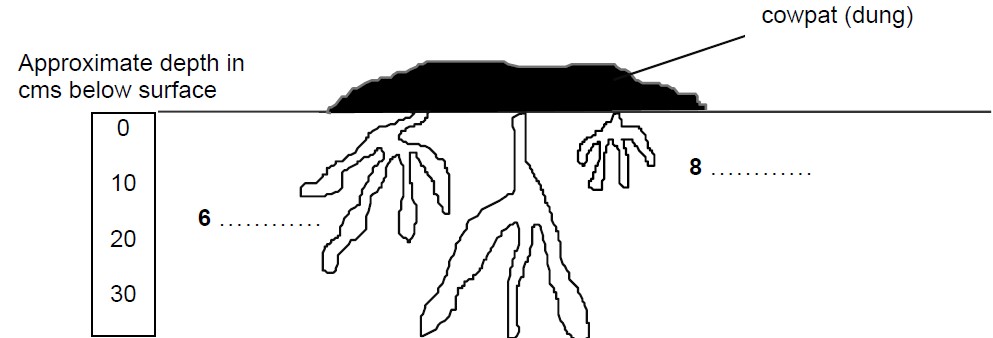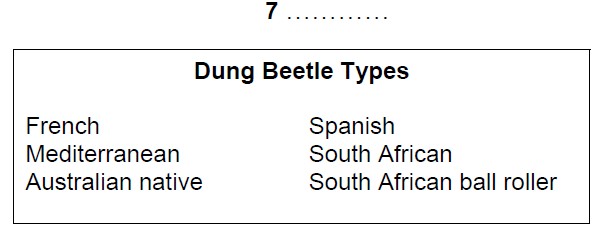雅思考生学术类阅读样本
雅思考生学术类阅读样本
学术阅读测试是60分钟长。
文本为学术阅读测试从图书、期刊、杂志和报纸。
使用多种问题,选择从以下类型:多种选择,识别信息,识别的作家的观点/索赔、匹配的信息,匹配标题,匹配特征,符合句子结尾,句子完成,总结完成,注意完成,表完成,集成完成,图标签完成,short-answer问题。
Academic Reading sample task – Diagram label completion
[Note: This is an extract from an Academic Reading passage on the subject of dung beetles. The text preceding this extract gave some background facts about dung beetles, and went on to describe a decision to introduce non-native varieties to Australia.]
Introducing dung1 beetles into a pasture is a simple process: approximately 1,500 beetles are released, a handful at a time, into fresh cow pats2 in the cow pasture. The beetles immediately disappear beneath the pats digging and tunnelling and, if they successfully adapt to their new environment, soon become a permanent, self-sustaining part of the local ecology. In time they multiply and within three or four years the benefits to the pasture are obvious.
Dung beetles work from the inside of the pat so they are sheltered from predators such as birds and foxes. Most species burrow into the soil and bury dung in tunnels directly underneath the pats, which are hollowed out from within. Some large species originating from France excavate tunnels to a depth of approximately 30 cm below the dung pat. These beetles make sausage-shaped brood chambers along the tunnels. The shallowest tunnels belong to a much smaller Spanish species that buries dung in chambers that hang like fruit from the branches of a pear tree. South African beetles dig narrow tunnels of approximately 20 cm below the surface of the pat. Some surface-dwelling beetles, including a South African species, cut perfectly-shaped balls from the pat, which are rolled away and attached to the bases of plants.
For maximum dung burial in spring, summer and autumn, farmers require a variety of species with overlapping periods of activity. In the cooler environments of the state of Victoria, the large French species (2.5 cms long), is matched with smaller (half this size), temperate-climate Spanish species. The former are slow to recover from the winter cold and produce only one or two generations of offspring from late spring until autumn. The latter, which multiply rapidly in early spring, produce two to five generations annually. The South African ball-rolling species, being a sub-tropical beetle, prefers the climate of northern and coastal New South Wales where it commonly works with the South African tunneling species. In warmer climates, many species are active for longer periods of the year.
Glossary
1. dung: the droppings or excreta of animals
2. cow pats: droppings of cows
Academic Reading sample task – Diagram label completion
Questions 6 – 8
Label the tunnels on the diagram below using words from the box.
Write your answers in boxes 6-8 on your answer sheet.


以上就是雅思考生学术类阅读样本的全部内容,希望对学员有所帮助。
更多关注:广州英语培训学校,英语培训

关于雅思小知识
什么时候考雅思,分数能高一点?
"雅思到底有没有一个高分时间表呢?尤其是口语考试,这种存在一定主观性的科目,有没有哪个时间段考出的雅思分数比较高呢?或者说几月份考雅思比较简单呢?”
那么,雅思考试有没有特定的时间去考,分数相对来说较高呢?今天就来跟各位烤鸭们探讨下~
01换题季
烤鸭们都知道,雅思口语有题库一说,如果你的口语备考比较充分,还是有很大的概率遇到原题的!
如果你平时在备考时把当季题库中的题目进行简单的合并,再认真准备一遍,并且不选择在换题季最初的时候进行考试,你会发现很多题目都是你平常见过的!相对于来说,考试难度下降了很多!
不过,一些烤鸭不得不选择在换题季考试(每年1月、5月、9月),在这三个月中,雅思官方一般会替换掉当季题库中30%-50%的题目。你可以来新航道北京学校,与雅思考试进行深度学习,同时能第 一时间掌握换题季新题目、新考试动态!
02寒暑假期后
有些烤鸭反馈,觉得假期前后考试比较容易拿到好分数,比如过年这段时间,这是为什么呢?
首先,对于一些正在上学的烤鸭来说,假期我们一般都会有很长的备考、复习时间,可以让我们做好充足的准备!这样,不仅提高自己备考期间的专注度,还能保持良好的学习状态,也一定程度上提高了备考效率!所以,赛暑假期也是一个不错的出分时间段!
同时,说到口语备考,我们在假期有了更多的时间来练习题库中的出现的题目,在考场上也能游刃有余的应对!
悄悄告诉各位烤鸭:“江湖上一直流传着圣诞节前后的题目会相对于来说比较平和!"
因为这段时间正好是海外院校招生季,所以需要通过控制雅思考试的难度来增加部分留学生生源。那么各位烤鸭一定要把握好这个时间段,雅思考试冲冲冲!
- 电话:400-0808-102
- 点击在线客服

























